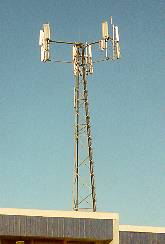|
OVERVIEW:
The criteria used for the selection of PCS antenna sites in this project
were chosen because of their relevancy in the actual decision process.
It must be stated, however, that the chosen criteria represent only a portion
of the actual factors used in the decision process.
Factors like surrounding building height, municipal building codes, the
presence of other carriers, and site owner cooperation are not included
in this project.

PCS Antenna Site
The first step was determining the constraints for potential site candidates.
The first constraint involved developing a hypothetical PCS network.
This will be explained in detail in the methodology
section. From this hypothetical
network, the areas of poor PCS reception (coverage holes) were noted.
These coverage holes were used as the starting point for determining the
location of new antennas, and became the first constraint.
The second constraint was water. Obviously, antenna sites can not be built
on water.
Next, factors were gathered. Land
use in an important factor in choosing antenna locations.
For example, residential areas are poor choices because of the public response
that the intrusive antennas usually receive.
Commercial areas are good choices, but rent can sometimes be higher than
industrial. Parks, and other
government land are also good locations, but building towers is usually
heavily regulated in these areas.
Proximity to other PCS sites
is also very important. Not
only is it not cost efficient to build antenna sites close to each other,
they can also interfere with each other and actually decrease the effectiveness
of the network.
Elevation is also an important factor.
If a site is too low, the distance the radio frequency (RF) signal can
travel is not very far. Also,
if a site is too high, the signal can carry far, interfering with other
sites.
Slope is another factor.
The steeper the slope, the more expensive the build will be.
Population is also important.
If there is a coverage hole in a sparsely populated area, it may not be
cost efficient to spend the money to install an antenna if it will have
limited capacity. This is
especially important when sites cost hundreds of thousands of dollars.
The proximity to major traffic
corridors is also an important factor.
During peak commuting times, cell phones are used most.
The strain on a network can be eased by sharing the capacity between sites.
Once these factors were chosen, the data was gathered from various sources.
Using several GIS programs and utilities, the data was gathered, clipped
and converted to IDRISI raster
format. IDRISI
v. I32.11 was used as the main analysis engine.
The input factor data was standardized into a continuous scale using a
non-Boolean approach. This
allows inputs to be "fuzzy".
Factors can trade off to determine each pixel's suitability.
For example, an area with a steep slope will be an expensive site to build,
but it may be chosen if there is high population nearby.
These inputs were then given weights, to account for the varying importance
that the input factors have on the final site selection.
This data was then aggregated by weighted linear combination, producing
a "suitability" grid for study area.
From this "suitability" grid, final site candidates were chosen.
[
Introduction
] [ Overview ] [ Data
] [ Methodology ] [ Analysis
] [ Results ]
[
Image
Gallery ] [ Contact Me ] [
Links
]
|









